Magnetic Ion-Imprinted Materials for Selective Adsorption of Cr(VI): Adsorption Behavior and Mechanism Study
Abstract
:1. Introduction
2. Results and Discussion
2.1. Characterization
2.1.1. FT-IR Spectroscopy
2.1.2. XRD
2.1.3. Thermal Stability Analysis
2.1.4. Magnetic Properties
2.1.5. HRTEM
2.1.6. EDS
2.2. Adsorption Properties
2.2.1. pH Effect on Adsorption
2.2.2. Adsorption Kinetics
2.2.3. Adsorption Isotherms
2.2.4. Thermodynamic Studies
2.3. Selective Adsorption
2.4. Mechanistic Studies
2.5. Practical Applications
3. Materials and Methods
3.1. Reagents
3.2. Instruments and Equipment
3.3. Preparation of Imprinted Materials
3.3.1. Preparation of Magnetic Fe3O4@GO Nanocomposite Matrices
3.3.2. Preparation of Graphene-Based Magnetic Cr(VI) Nano-Imprinted Polymers
3.4. Adsorption Experiments
3.5. DFT Calculations
4. Conclusions
Supplementary Materials
Author Contributions
Funding
Institutional Review Board Statement
Informed Consent Statement
Data Availability Statement
Conflicts of Interest
References
- Sun, Y.-Y.; Li, Q.-S.; Jiang, H.-M.; Li, Y.-H.; Zhu, M.-S.; Miao, L.-K.; Zhou, H.-Z.; Huang, J.-W.; Fan, X.-X.; Wang, J.-F. Microbial communities outperform extracellular polymeric substances in the reduction of hexavalent chromium by anaerobic granular sludge. Environ. Technol. Innov. 2024, 34, 103616. [Google Scholar] [CrossRef]
- Kamila, S.; Shaw, P.; Islam, S.; Chattopadhyay, A. Ecotoxicology of hexavalent chromium in fish: An updated review. Sci. Total Environ. 2023, 890, 164395. [Google Scholar] [CrossRef] [PubMed]
- Singh, V.; Singh, N.; Verma, M.; Kamal, R.; Tiwari, R.; Sanjay Chivate, M.; Rai, S.N.; Kumar, A.; Singh, A.; Singh, M.P.; et al. Hexavalent-Chromium-Induced Oxidative Stress and the Protective Role of Antioxidants against Cellular Toxicity. Antioxidants 2022, 11, 2375. [Google Scholar] [CrossRef] [PubMed]
- Muhammad Ekramul Mahmud, H.N.; Huq, A.K.O.; Yahya, R.b. The removal of heavy metal ions from wastewater/aqueous solution using polypyrrole-based adsorbents: A review. RSC Adv. 2016, 6, 14778–14791. [Google Scholar] [CrossRef]
- Rajapaksha, A.U.; Selvasembian, R.; Ashiq, A.; Gunarathne, V.; Ekanayake, A.; Perera, V.O.; Wijesekera, H.; Mia, S.; Ahmad, M.; Vithanage, M.; et al. A systematic review on adsorptive removal of hexavalent chromium from aqueous solutions: Recent advances. Sci. Total Environ. 2022, 809, 152055. [Google Scholar] [CrossRef]
- Abidli, A.; Huang, Y.; Ben Rejeb, Z.; Zaoui, A.; Park, C.B. Sustainable and efficient technologies for removal and recovery of toxic and valuable metals from wastewater: Recent progress, challenges, and future perspectives. Chemosphere 2022, 292, 133102. [Google Scholar] [PubMed]
- Jyoti; Singh, S.; Das, S.; Srivastava, S. Comparative study for removal of toxic hexavalent chromium by zinc oxide nanoparticles, chitosan, chitin and zinc-chitosan nano-biocomposite. Environ. Technol. Innov. 2023, 32, 103310. [Google Scholar] [CrossRef]
- Thiripelu, P.; Manjunathan, J.; Revathi, M.; Ramasamy, P. Removal of hexavalent chromium from electroplating wastewater by ion-exchange in presence of Ni(II) and Zn(II) ions. J. Water Process Eng. 2024, 58, 104815. [Google Scholar] [CrossRef]
- Liu, R.; Chi, L.; Wang, X.; Sui, Y.; Wang, Y.; Arandiyan, H. Review of metal(hydr)oxide and other adsorptive materials for phosphate removal from water. J. Environ. Chem. Eng. 2018, 6, 5269–5286. [Google Scholar] [CrossRef]
- Basnet, P.; Gyawali, D.; Nath Ghimire, K.; Paudyal, H. An assessment of the lignocellulose-based biosorbents in removing Cr(VI) from contaminated water: A critical review. Results Chem. 2022, 4, 100406. [Google Scholar] [CrossRef]
- Kumar, S.; Alveroğlu, E.; Balouch, A.; Talpur, F.N.; Jagirani, M.S.; Abdullah; Mahar, A.M.; Pato, A.H.; Mal, D.; Lal, S. Fabrication of chromium-imprinted polymer: A real magneto-selective sorbent for the removal of Cr(VI) ions in real water samples. New J. Chem. 2020, 44, 18668–18678. [Google Scholar] [CrossRef]
- An, F.-Q.; Li, H.-F.; Guo, X.-D.; Gao, B.-J.; Hu, T.-P.; Gao, J.-F. Novel ionic surface imprinting technology: Design and application for selectively recognizing heavy metal ions. RSC Adv. 2019, 9, 2431–2440. [Google Scholar] [CrossRef]
- Li, Y.; Tian, J.; Li, Y.; He, H.; Deng, X.; Li, W.; Zhang, Y.; Zhao, X.; Chen, W.-T.; Hu, G. Cross-linking copolymerization on magnetic microspheres surface induced neodymium ion imprinting for high capacity and high selectivity removal of Nd3+ from aqueous solution. Surf. Interfaces 2023, 43, 103587. [Google Scholar] [CrossRef]
- Muthu Prabhu, S.; Rane, N.R.; Li, X.; Otari, S.V.; Girawale, S.D.; Palake, A.R.; Kodam, K.M.; Park, Y.-K.; Ha, Y.-H.; Kumar Yadav, K.; et al. Magnetic nanostructured adsorbents for water treatment: Structure-property relationships, chemistry of interactions, and lab-to-industry integration. Chem. Eng. J. 2023, 468, 143474. [Google Scholar] [CrossRef]
- Hassanpour, S.; Taghizadeh, M.; Yamini, Y. Magnetic Cr(VI) Ion Imprinted Polymer for the Fast Selective Adsorption of Cr(VI) from Aqueous Solution. J. Polym. Environ. 2017, 26, 101–115. [Google Scholar] [CrossRef]
- Jazzar, A.; Alamri, H.; Malajati, Y.; Mahfouz, R.; Bouhrara, M.; Fihri, A. Recent advances in the synthesis and applications of magnetic polymer nanocomposites. J. Ind. Eng. Chem. 2021, 99, 1–18. [Google Scholar] [CrossRef]
- Parambil, A.M.; Rajan, S.; Huang, P.-C.; Shashikumar, U.; Tsai, P.-C.; Rajamani, P.; Lin, Y.-C.; Ponnusamy, V.K. Carbon and graphene quantum dots based architectonics for efficient aqueous decontamination by adsorption chromatography technique-Current state and prospects. Environ. Res. 2024, 251, 118541. [Google Scholar] [CrossRef]
- Neolaka, Y.A.B.; Lawa, Y.; Naat, J.; Riwu, A.A.P.; Lindu, Y.E.; Darmokoesoemo, H.; Widyaningrum, B.A.; Iqbal, M.; Kusuma, H.S. Evaluation of magnetic material IIP@GO-Fe3O4 based on Kesambi wood (Schleichera oleosa) as a potential adsorbent for the removal of Cr(VI) from aqueous solutions. React. Funct. Polym. 2021, 166, 105000. [Google Scholar] [CrossRef]
- Lin, L.; Guo, H.; Lin, S.; Chen, Y.; Yan, L.; Zhu, E.; Li, K. Selective extraction of perfluorooctane sulfonate in real samples by superparamagnetic nanospheres coated with a polydopamine-based molecularly imprinted polymer. J. Sep. Sci. 2021, 44, 1015–1025. [Google Scholar] [CrossRef]
- Zhang, M.; Yu, Z.; Yu, H. Adsorption of Eosin Y, methyl orange and brilliant green from aqueous solution using ferroferric oxide/polypyrrole magnetic composite. Polym. Bull. 2019, 77, 1049–1066. [Google Scholar] [CrossRef]
- Talebi, F.; Rafiee, Z. Superparamagnetic nanocomposites: Prepared by embedding Fe3O4@graphene oxide in chiral poly(amide–imide). Polym. Bull. 2019, 77, 2059–2071. [Google Scholar] [CrossRef]
- Wan, W.; Xia, N.; Zhu, S.; Liu, Q.; Gao, Y. A Novel and High-Effective Biosynthesis Pathway of Hesperetin-7-O-Glucoside Based on the Construction of Immobilized Rhamnosidase Reaction Platform. Front. Bioeng. Biotechnol. 2020, 8, 608. [Google Scholar] [CrossRef] [PubMed]
- Huang, Y.; Wang, Y.; Pan, Q.; Wang, Y.; Ding, X.; Xu, K.; Li, N.; Wen, Q. Magnetic graphene oxide modified with choline chloride-based deep eutectic solvent for the solid-phase extraction of protein. Anal. Chim. Acta 2015, 877, 90–99. [Google Scholar] [CrossRef]
- Xiao, G.; Gao, X.; Yan, W.; Wu, T.; Peng, X. Baeyer–Villiger Oxidation of Cyclohexanone by Hydrogen Peroxide with Fe3O4@GO as Catalyst Under Solvent Free Conditions. Catal. Lett. 2019, 149, 1765–1771. [Google Scholar] [CrossRef]
- Alvand, M.; Shemirani, F. Fabrication of Fe3O4@graphene oxide core-shell nanospheres for ferrofluid-based dispersive solid phase extraction as exemplified for Cd(II) as a model analyte. Microchim. Acta 2016, 183, 1749–1757. [Google Scholar] [CrossRef]
- Zhang, H.; Dai, Z.; Sui, Y.; Xue, J.; Ding, D. Adsorption of U(VI) from aqueous solution by magnetic core–dual shell Fe3O4@PDA@TiO2. J. Radioanal. Nucl. Chem. 2018, 317, 613–624. [Google Scholar] [CrossRef]
- Arcos-Casarrubias, J.A.; Cruz-Díaz, M.R.; Cardoso-Martínez, J.; Vázquez-Arenas, J.; Caballero-Domínguez, F.V. Chromium adsorption into a macroporous resin based on vinylpyridine–divinylbenzene copolymers: Thermodynamics, kinetics, and process dynamic in a fixed bed column. Adsorption 2017, 24, 105–120. [Google Scholar] [CrossRef]
- Gusain, D.; Srivastava, V.; Sillanpää, M.; Sharma, Y.C. Kinetics and isotherm study on adsorption of chromium on nano crystalline iron oxide/hydroxide: Linear and nonlinear analysis of isotherm and kinetic parameters. Res. Chem. Intermed. 2016, 42, 7133–7151. [Google Scholar] [CrossRef]
- Svarovskaya, N.; Bakina, O.; Glazkova, E.; Rodkevich, N.; Lerner, M.; Vornakova, E.; Chzhou, V.; Naumova, L. Synthesis of novel hierarchical micro/nanostructures AlOOH/AlFe and their application for As(V) removal. Environ. Sci. Pollut. Res. 2021, 29, 1246–1258. [Google Scholar] [CrossRef] [PubMed]
- Jabar, J.M.; Adebayo, M.A.; Odusote, Y.A.; Yılmaz, M.; Rangabhashiyam, S. Valorization of microwave-assisted H3PO4− activated plantain (Musa paradisiacal L) leaf biochar for malachite green sequestration: Models and mechanism of adsorption. Results Eng. 2023, 18, 101129. [Google Scholar] [CrossRef]
- Bedin, K.C.; de Azevedo, S.P.; Leandro, P.K.T.; Cazetta, A.L.; Almeida, V.C. Bone char prepared by CO2 atmosphere: Preparation optimization and adsorption studies of Remazol Brilliant Blue R. J. Cleaner Prod. 2017, 161, 288–298. [Google Scholar] [CrossRef]
- Huang, H.; Wang, Y.; Zhang, Y.; Niu, Z.; Li, X. Amino-functionalized graphene oxide for Cr(VI), Cu(II), Pb(II) and Cd(II) removal from industrial wastewater. Open Chem. 2020, 18, 97–107. [Google Scholar] [CrossRef]
- Jabar, J.M.; Adebayo, M.A.; Owokotomo, I.A.; Odusote, Y.A.; Yılmaz, M. Synthesis of high surface area mesoporous ZnCl2–activated cocoa (Theobroma cacao L) leaves biochar derived via pyrolysis for crystal violet dye removal. Heliyon 2022, 8, e10873. [Google Scholar] [CrossRef] [PubMed]
- Foo, K.Y. Value-added utilization of maize cobs waste as an environmental friendly solution for the innovative treatment of carbofuran. Process Saf. Environ. Prot. 2016, 100, 295–304. [Google Scholar] [CrossRef]
- Singh Rathore, A.; Kishore Gupta, G.; Kapur, M.; Kumar Mondal, M. Study on mass transfer characteristics for Cr(VI) removal by adsorption onto residual black toner ink. Environ. Prog. Sustain. Energy 2017, 36, 1022–1029. [Google Scholar] [CrossRef]
- Fan, G.; Zhang, C.; Wang, T.; Deng, J.; Cao, Y.; Chang, L.; Zhou, G.; Wu, Y.; Li, P. New insight into surface adsorption thermodynamic, kinetic properties and adsorption mechanisms of sodium oleate on ilmenite and titanaugite. Adv. Powder Technol. 2020, 31, 3628–3639. [Google Scholar] [CrossRef]
- Chen, Z.; Wei, B.; Yang, S.; Li, Q.; Liu, L.; Yu, S.; Wen, T.; Hu, B.; Chen, J.; Wang, X. Synthesis of PANI/AlOOH composite for Cr(VI) adsorption and reduction from aqueous solutions. ChemistrySelect 2019, 4, 2352–2362. [Google Scholar] [CrossRef]
- Neolaka, Y.A.B.; Supriyanto, G.; Kusuma, H.S. Adsorption performance of Cr(VI)-imprinted poly(4-VP-CO-MMA) supported on activated Indonesia (Ende-Flores) natural zeolite structure for Cr(VI) removal from aqueous solution. J. Environ. Chem. Eng. 2018, 6, 3436–3443. [Google Scholar] [CrossRef]
- Taghizadeh, M.; Hassanpour, S. Selective adsorption of Cr(VI) ions from aqueous solutions using a Cr(VI)-imprinted polymer supported by magnetic multiwall carbon nanotubes. Polymer 2017, 132, 1–11. [Google Scholar] [CrossRef]
- Wang, G.; Hua, Y.; Su, X.; Komarneni, S.; Ma, S.; Wang, Y. Cr(VI) adsorption by montmorillonite nanocomposites. Appl. Clay Sci. 2016, 124–125, 111–118. [Google Scholar] [CrossRef]
- Xu, M.; Ma, X.; Chen, Y.; Hu, L.; Wang, B.; Qiu, M. Spectroscopic investigation of Cr(VI) sorption on nZVI/biochar composites. J. Mol. Liq. 2022, 366, 120262. [Google Scholar] [CrossRef]
- Maaz, M.; Elzein, T.; Bejjani, A.; Barroca-Aubry, N.; Lepoittevin, B.; Dragoe, D.; Mazerat, S.; Nsouli, B.; Roger, P. Surface initiated supplemental activator and reducing agent atom transfer radical polymerization (SI-SARA-ATRP) of 4-vinylpyridine on poly(ethylene terephthalate). J. Colloid Interface Sci. 2017, 500, 69–78. [Google Scholar] [CrossRef] [PubMed]
- Luo, D.; Geng, R.; Zhang, Y.; Li, P.; Liang, J.; Fan, Q.; Qiang, S. Interaction behaviors of Cr(VI) at biotite-water interface in the presence of HA: Batch, XRD and XPS investigations. Chemosphere 2022, 293, 133585. [Google Scholar] [CrossRef] [PubMed]
- Ren, Z.; Xu, X.; Wang, X.; Gao, B.; Yue, Q.; Song, W.; Zhang, L.; Wang, H. FTIR, Raman, and XPS analysis during phosphate, nitrate and Cr(VI) removal by amine cross-linking biosorbent. J. Colloid Interface Sci. 2016, 468, 313–323. [Google Scholar] [CrossRef] [PubMed]
- Wu, C.; Zheng, J.; Hu, J. Novel antifouling polysulfone matrix membrane modified with zwitterionic polymer. J. Saudi Chem. Soc. 2021, 25, 101281. [Google Scholar] [CrossRef]
- Magero, D.; Casida, M.E.; Amolo, G.; Makau, N.; Kituyi, L. Partial density of states ligand field theory (PDOS-LFT): Recovering a LFT-like picture and application to photoproperties of ruthenium(II) polypyridine complexes. J. Photochem. Photobiol. A 2017, 348, 305–325. [Google Scholar] [CrossRef]
- Hu, H.; Ren, Z.; Xi, Y.; Fang, L.; Fang, D.; Yang, L.; Shao, P.; Shi, H.; Yu, K.; Luo, X. Insights into the role of cross-linking agents on polymer template effect: A case study of anionic imprinted polymers. Chem. Eng. J. 2021, 420, 129611. [Google Scholar] [CrossRef]
- Liu, L.; Chang, S.; Wang, Y.; Zhao, H.; Wang, S.; Zheng, C.; Ding, Y.; Ren, S.; Zhang, J.; Guo, Y.-R. Facile fabrication of ion-imprinted Fe3O4/carboxymethyl cellulose magnetic biosorbent: Removal and recovery properties for trivalent La ions. RSC Adv. 2021, 11, 25258–25265. [Google Scholar] [CrossRef]
- Ni, C.; Liu, Q.; Ren, Z.; Hu, H.; Sun, B.; Liu, C.; Shao, P.; Yang, L.; Pavlostathis, S.G.; Luo, X. Selective removal and recovery of La(III) using a phosphonic-based ion imprinted polymer: Adsorption performance, regeneration, and mechanism. J. Environ. Chem. Eng. 2021, 9, 106701. [Google Scholar] [CrossRef]
- Lu, T.; Chen, F. Multiwfn: A multifunctional wavefunction analyzer. J. Comput. Chem. 2011, 33, 580–592. [Google Scholar] [CrossRef]

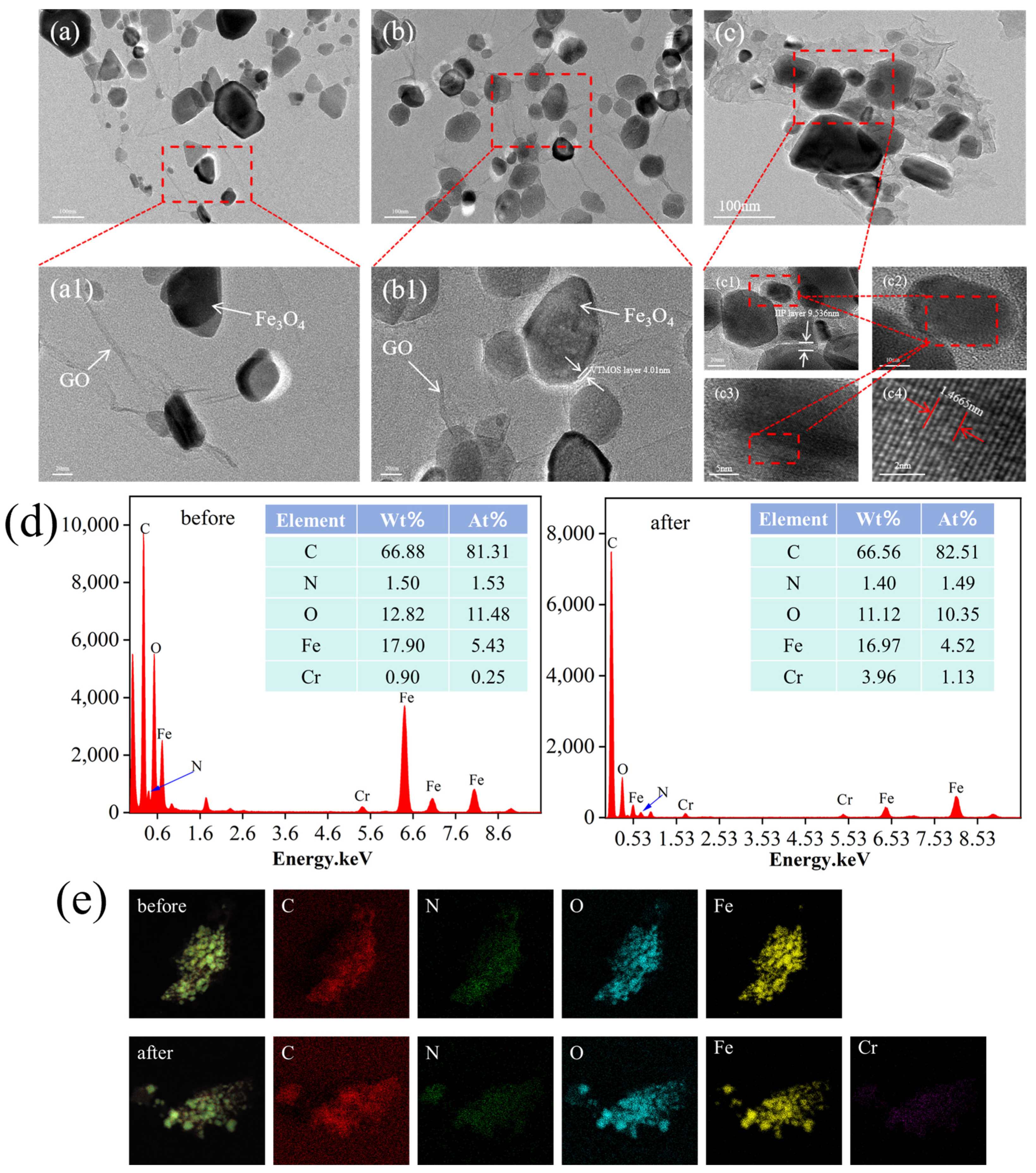

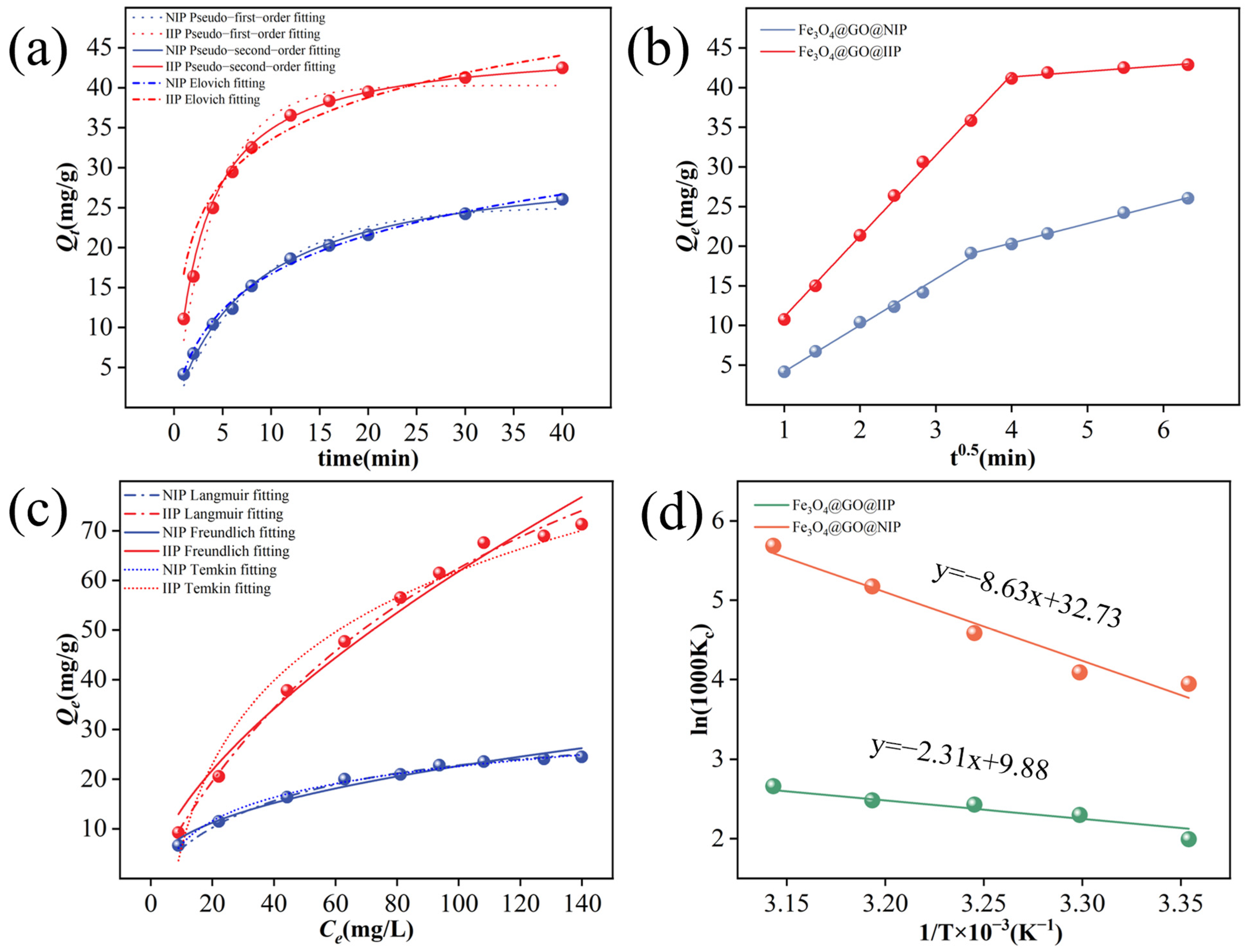


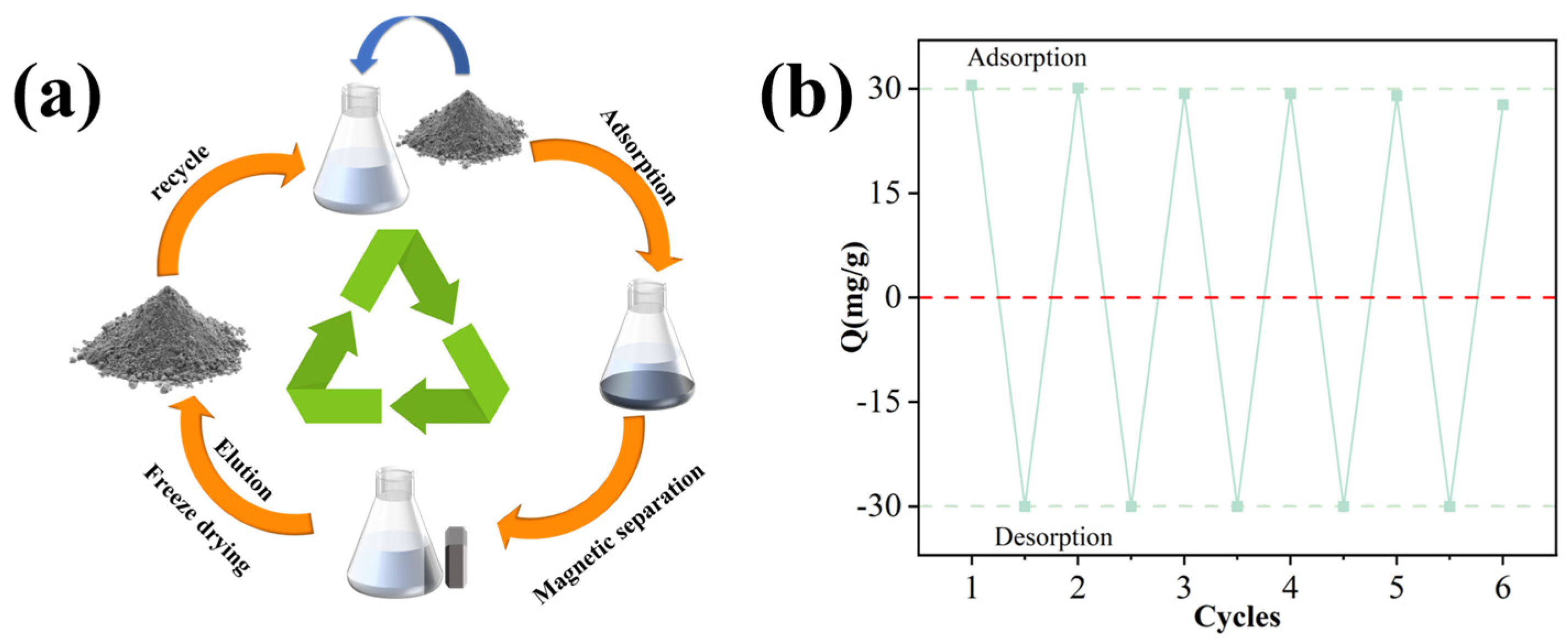


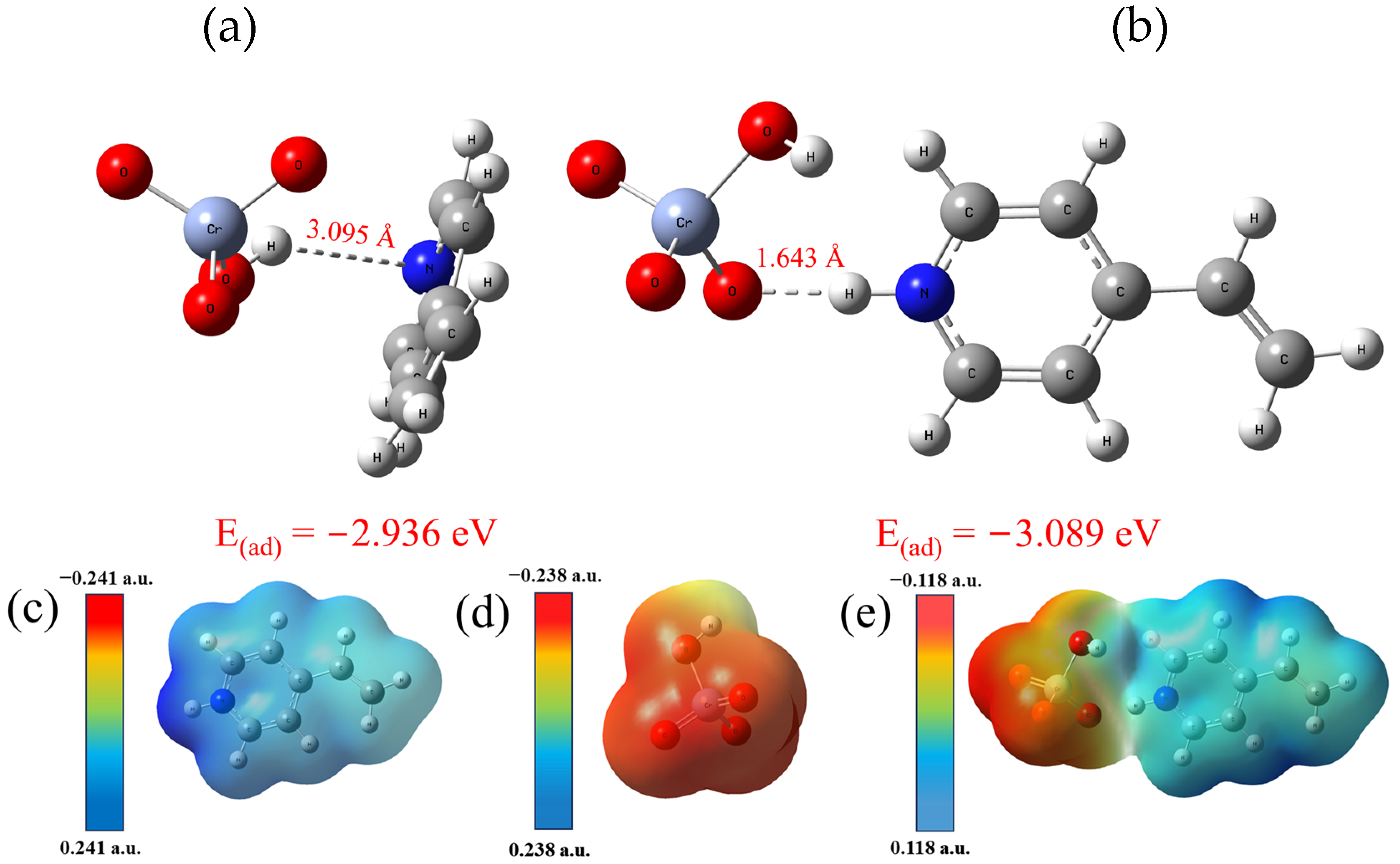
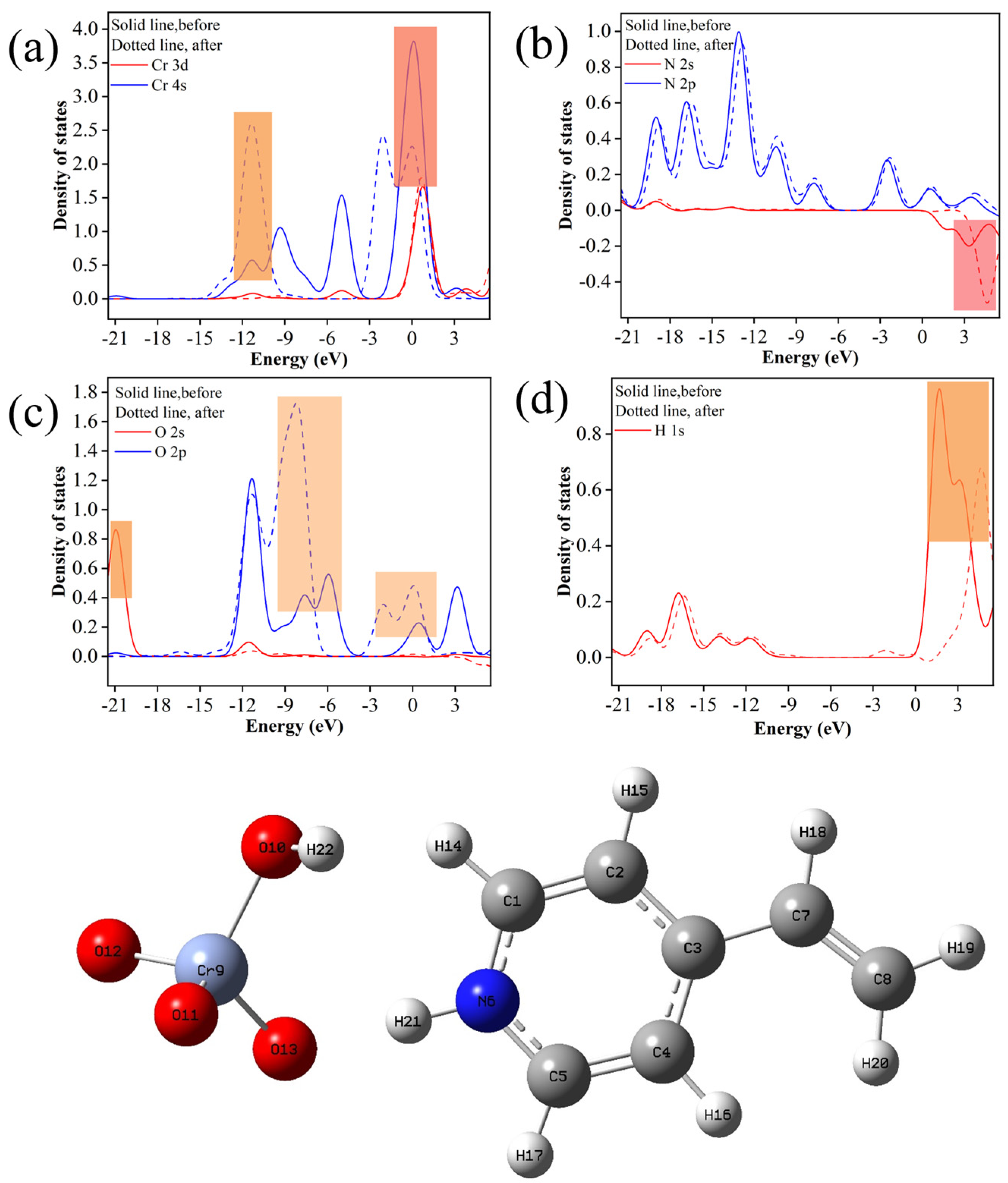

| Adsorbents | Qe,exp | Pseudo−First−Order | Pseudo−Second−Order | Elovich | |||||||
|---|---|---|---|---|---|---|---|---|---|---|---|
| Qe | k1 | R12 | Qe | k2 | R22 | Qe | k3 | R32 | a | ||
| IIP | 42.80 | 40.27 | 0.2337 | 0.9879 | 42.21 | 0.0072 | 0.9963 | 44.05 | 0.1306 | 0.9554 | 4.832 |
| NIP | 26.02 | 24.87 | 0.1154 | 0.9818 | 25.80 | 0.0039 | 0.9912 | 26.50 | 0.1303 | 0.9820 | 5.997 |
| Adsorbents | Qe,exp | Langmuir | Freundlich | Temkin | |||||||
|---|---|---|---|---|---|---|---|---|---|---|---|
| Qe | kL | R12 | Qe | kF | n | R22 | Qe | kt | R32 | ||
| IIP | 73.80 | 74.06 | 0.0082 | 0.9994 | 76.54 | 3.1417 | 1.5457 | 0.9772 | 69.87 | 0.1299 | 0.9737 |
| NIP | 21.60 | 24.92 | 0.0227 | 0.9934 | 26.20 | 3.0431 | 2.2934 | 0.9783 | 24.50 | 0.2734 | 0.9807 |
| Adsorbent | Temperature (K) | ΔG (kJ/mol) | ΔH (kJ/mol) | ΔS (kJ/mol·K) |
|---|---|---|---|---|
| IIP | 298 | −10.4299 | 0.07180 | 0.2721 |
| 303 | −10.6399 | |||
| 308 | −11.7364 | |||
| 313 | −13.0324 | |||
| 318 | −14.0872 | |||
| NIP | 298 | −5.2681 | 0.01923 | 0.0821 |
| 303 | −5.8866 | |||
| 308 | −6.1461 | |||
| 313 | −6.3207 | |||
| 318 | −6.7006 |
| Metal Ion | IIP | NIP | k′ | ||||
|---|---|---|---|---|---|---|---|
| Qe (mg/g) | D (mL/g) | k | Qe (mg/g) | D (mL/g) | k | ||
| Cr(VI) | 42.5300 | 5693.4 | 22.570 | 822.8 | |||
| Cd(II) | 0.9610 | 19.6 | 290.4796 | 0.8970 | 18.2 | 45.2088 | 6.4253 |
| Fe(III) | 5.3787 | 120.5 | 47.2481 | 4.9435 | 109.7 | 7.5005 | 6.2993 |
Disclaimer/Publisher’s Note: The statements, opinions and data contained in all publications are solely those of the individual author(s) and contributor(s) and not of MDPI and/or the editor(s). MDPI and/or the editor(s) disclaim responsibility for any injury to people or property resulting from any ideas, methods, instructions or products referred to in the content. |
© 2024 by the authors. Licensee MDPI, Basel, Switzerland. This article is an open access article distributed under the terms and conditions of the Creative Commons Attribution (CC BY) license (https://creativecommons.org/licenses/by/4.0/).
Share and Cite
Li, S.; Ye, S.; Zhang, W.; He, H.; Zhang, Y.; Xiong, M.; Chen, Y.; Wang, M.; Nie, Z. Magnetic Ion-Imprinted Materials for Selective Adsorption of Cr(VI): Adsorption Behavior and Mechanism Study. Molecules 2024, 29, 1952. https://doi.org/10.3390/molecules29091952
Li S, Ye S, Zhang W, He H, Zhang Y, Xiong M, Chen Y, Wang M, Nie Z. Magnetic Ion-Imprinted Materials for Selective Adsorption of Cr(VI): Adsorption Behavior and Mechanism Study. Molecules. 2024; 29(9):1952. https://doi.org/10.3390/molecules29091952
Chicago/Turabian StyleLi, Shunfei, Siqing Ye, Weiye Zhang, Hongxing He, Yi Zhang, Mingyang Xiong, Yuhan Chen, Mingqiu Wang, and Zhifeng Nie. 2024. "Magnetic Ion-Imprinted Materials for Selective Adsorption of Cr(VI): Adsorption Behavior and Mechanism Study" Molecules 29, no. 9: 1952. https://doi.org/10.3390/molecules29091952






